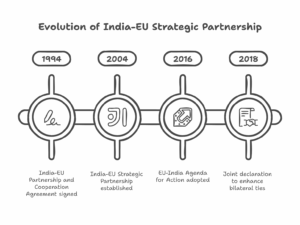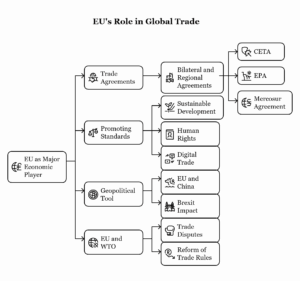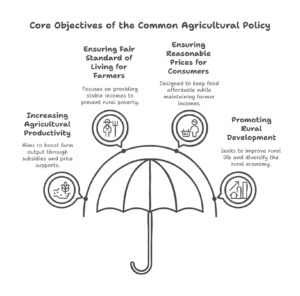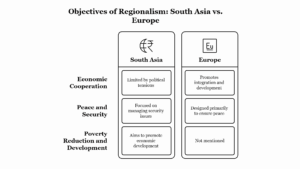The European Union (EU) has developed multifaceted and dynamic relationships with various regional groupings in Asia. These interactions are rooted in shared interests such as economic cooperation, regional stability, trade agreements, and environmental sustainability. However, the nature of the EU’s relationship with Asian regional groupings varies depending on historical contexts, political goals, and economic considerations. This answer will examine the primary regional groupings in Asia, namely ASEAN, SAARC, and the Shanghai Cooperation Organization (SCO), and assess the EU’s engagement with them.
1. The EU and ASEAN: A Strategic Partnership
The Association of Southeast Asian Nations (ASEAN) is one of the most significant regional groupings in Asia, consisting of ten Southeast Asian nations: Brunei, Cambodia, Indonesia, Laos, Malaysia, Myanmar, Philippines, Singapore, Thailand, and Vietnam. ASEAN plays a central role in promoting regional cooperation and economic integration. The EU’s relationship with ASEAN is built on shared goals of peace, prosperity, and development.
1.1 Trade and Economic Cooperation
The EU’s relationship with ASEAN is primarily focused on economic diplomacy. ASEAN is one of the EU’s largest trading partners, with the EU being ASEAN’s second-largest trade partner after China. The EU-ASEAN relationship is centered around the EU-ASEAN Free Trade Agreement (FTA) and regional trade agreements. These agreements aim to promote trade liberalization, reduce barriers, and ensure economic integration within the region.
- EU-ASEAN Trade: The EU has been involved in several initiatives to boost economic ties with ASEAN. Through the EU-ASEAN Economic Cooperation agreement, the EU facilitates market access, encourages sustainable development, and shares expertise in areas such as environmental protection, public health, and education.
- The EU-ASEAN Connectivity Agenda: Launched in 2018, the EU-ASEAN Connectivity Agenda focuses on improving physical, institutional, and people-to-people connectivity. This initiative aims to build infrastructure links, improve digital connectivity, and enhance mobility between ASEAN countries and the EU.
1.2 Political and Security Dialogue
Apart from trade, the EU engages with ASEAN on political and security issues through a dialogue format that includes the EU-ASEAN Foreign Ministers’ Meetings. Both parties have cooperated on issues such as maritime security, counter-terrorism, human rights, and conflict resolution. The EU has also supported ASEAN in its efforts to promote regional peace and stability, especially in the context of the South China Sea disputes.
1.3 Environmental and Climate Cooperation
The EU and ASEAN share common goals regarding climate change and sustainable development. The EU is one of the largest contributors to ASEAN’s climate change mitigation and adaptation efforts. The EU-ASEAN cooperation on climate change addresses issues such as green technology, carbon emissions, and environmental sustainability.
2. The EU and SAARC: Limited Engagement with South Asia
The South Asian Association for Regional Cooperation (SAARC) consists of eight countries in South Asia: Afghanistan, Bangladesh, Bhutan, India, Maldives, Nepal, Pakistan, and Sri Lanka. While SAARC is an important regional organization, the EU’s engagement with it has been relatively limited compared to its involvement with ASEAN.
2.1 Political and Economic Relations
The EU has had a mixed approach to SAARC, mainly focusing on individual relationships with South Asian countries rather than the collective framework of SAARC. The EU has strong bilateral ties with key South Asian countries, especially India and Pakistan, which are the two largest and most influential members of SAARC.
- EU-India Relations: The EU has developed a robust strategic partnership with India based on trade, sustainable development, and global governance. India’s growing role as an economic power and its strategic importance in the Indo-Pacific region has led to enhanced EU-India cooperation on several fronts, including climate change, security, and trade.
- EU-Pakistan Relations: The EU’s relationship with Pakistan has been shaped by trade agreements, counter-terrorism cooperation, and human rights concerns. The EU also supports Pakistan’s development efforts through financial aid, particularly in education, poverty reduction, and healthcare.
2.2 Challenges to Deeper SAARC Engagement
Despite the potential for cooperation in economic development and regional security, SAARC has struggled with internal divisions, particularly between India and Pakistan, which has limited the EU’s ability to engage more directly with the organization. SAARC’s limited institutional strength and lack of effective decision-making mechanisms have also hindered its potential as a partner for the EU. As a result, the EU has focused more on bilateral ties with individual countries rather than engaging with SAARC as a bloc.
3. The EU and the Shanghai Cooperation Organization (SCO): Limited Interaction
The Shanghai Cooperation Organization (SCO), which includes countries like China, Russia, India, and several Central Asian nations, represents an important regional political and security organization. However, the EU’s relationship with the SCO is less developed due to differences in geopolitical priorities, values, and governance models.
3.1 Trade Relations with SCO Members
While the EU does not have a formal relationship with the SCO, it has significant economic ties with key members, particularly China and India. The EU is China’s largest trading partner, and its trade relations with India are robust, as mentioned earlier. The EU also engages with Russia on a range of economic and political issues, though relations have been strained due to differences over Ukraine and other geopolitical concerns.
3.2 Political and Security Concerns
The EU’s engagement with the SCO has been limited by its concerns over human rights, democratic governance, and rule of law in countries like China and Russia. The EU’s political stance on issues such as the Syria conflict and Ukraine has led to a more cautious approach toward engaging with the SCO as a bloc. Additionally, the EU has reservations about the security-centric nature of the SCO, which contrasts with the EU’s emphasis on multilateral diplomacy and rule-based international order.

4. Conclusion
The European Union’s relationships with regional groupings in Asia are shaped by a variety of factors, including economic interests, political alignments, historical ties, and shared global challenges. The EU’s relationship with ASEAN stands out as the most developed, with both sides engaging in trade and political dialogue and cooperating on climate change and sustainable development. In contrast, the EU’s engagement with SAARC has been more limited due to regional divisions, while its interaction with the SCO is constrained by political and security differences. Overall, while the EU continues to strengthen its partnerships in Asia, the varying dynamics within these regional groupings present both opportunities and challenges for deeper cooperation.








Leave a Reply